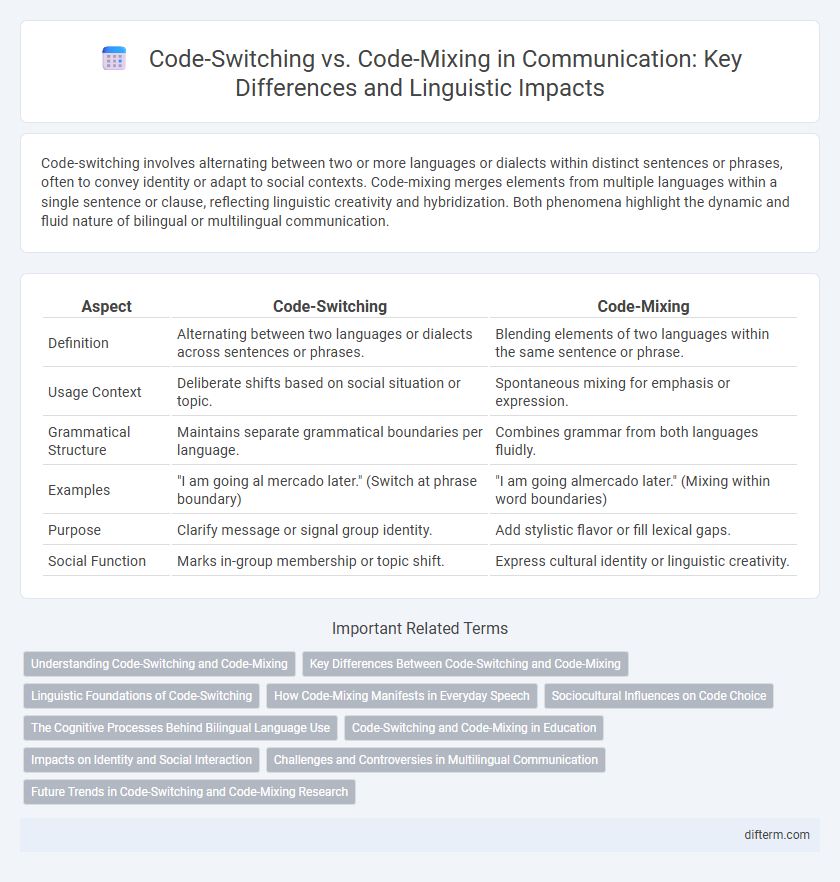Code-switching involves alternating between two or more languages or dialects within distinct sentences or phrases, often to convey identity or adapt to social contexts. Code-mixing merges elements from multiple languages within a single sentence or clause, reflecting linguistic creativity and hybridization. Both phenomena highlight the dynamic and fluid nature of bilingual or multilingual communication.
Table of Comparison
| Aspect | Code-Switching | Code-Mixing |
|---|---|---|
| Definition | Alternating between two languages or dialects across sentences or phrases. | Blending elements of two languages within the same sentence or phrase. |
| Usage Context | Deliberate shifts based on social situation or topic. | Spontaneous mixing for emphasis or expression. |
| Grammatical Structure | Maintains separate grammatical boundaries per language. | Combines grammar from both languages fluidly. |
| Examples | "I am going al mercado later." (Switch at phrase boundary) | "I am going almercado later." (Mixing within word boundaries) |
| Purpose | Clarify message or signal group identity. | Add stylistic flavor or fill lexical gaps. |
| Social Function | Marks in-group membership or topic shift. | Express cultural identity or linguistic creativity. |
Understanding Code-Switching and Code-Mixing
Code-switching involves alternating between two or more languages or dialects within a conversation while maintaining clear boundaries between each language. Code-mixing merges elements from multiple languages within a single sentence or phrase, creating a blended linguistic structure. Understanding the distinctions between code-switching and code-mixing enhances comprehension of multilingual communication dynamics and sociolinguistic identity expression.
Key Differences Between Code-Switching and Code-Mixing
Code-switching involves alternating between two distinct languages or dialects within a conversation, often marked by clear boundaries between linguistic structures. In contrast, code-mixing blends elements from multiple languages within a single sentence or phrase, resulting in a more integrated linguistic fusion. The key differences center on the degree of language integration and the functional purpose in communication, with code-switching serving pragmatic shifts and code-mixing reflecting deeper linguistic interdependence.
Linguistic Foundations of Code-Switching
Code-switching involves alternating between distinct language systems within a conversation, grounded in sociolinguistic rules and pragmatic competence. It reflects a speaker's ability to navigate multiple grammatical structures to convey meaning effectively, while code-mixing blends lexical items and morphemes from different languages within a single utterance. Linguistic foundations emphasize the role of syntactic constraints, language dominance, and conversational context in shaping patterns of code-switching in bilingual communication.
How Code-Mixing Manifests in Everyday Speech
Code-mixing manifests in everyday speech through the seamless blending of lexical items, phrases, or clauses from two or more languages within a single utterance or conversation, often reflecting cultural identity and social context. Unlike code-switching, which involves switching between distinct language systems at sentence or clause boundaries, code-mixing occurs within a sentence, creating hybrid expressions that convey nuanced meanings and social cues. This phenomenon is prevalent in multilingual communities where speakers fluidly integrate elements from dominant and minority languages to optimize communication effectiveness and group affiliation.
Sociocultural Influences on Code Choice
Sociocultural influences shape code-switching and code-mixing, as speakers navigate identity, group membership, and social norms within multilingual communities. Code-switching often signals shifting social roles or contexts, while code-mixing reflects fluid language boundaries and hybrid cultural expressions. These language choices are driven by situational factors, power dynamics, and the desire to align with or distance from particular social groups.
The Cognitive Processes Behind Bilingual Language Use
Code-switching involves alternating between two languages in distinct utterances, while code-mixing blends elements of both languages within a single sentence, engaging complex cognitive mechanisms such as executive control and language activation. Bilingual speakers activate competing linguistic systems simultaneously, requiring efficient neural coordination to manage interference and select appropriate language outputs. Neurocognitive studies reveal that these processes enhance mental flexibility, working memory, and attention control, underlying proficient bilingual communication strategies.
Code-Switching and Code-Mixing in Education
Code-switching in education facilitates cognitive flexibility by allowing students to alternate between languages within a learning environment, enhancing comprehension and engagement. Code-mixing integrates elements from multiple languages simultaneously, fostering creativity but sometimes causing confusion in language acquisition. Both practices support bilingual education by reflecting students' linguistic realities and promoting inclusive communication strategies.
Impacts on Identity and Social Interaction
Code-switching allows bilingual individuals to align their identity with specific social contexts, signaling group membership and social roles through shifting language use. In contrast, code-mixing blends linguistic elements within a single conversation, reflecting a hybrid identity and facilitating fluid communication across cultural boundaries. Both phenomena influence social interaction by negotiating power dynamics, fostering inclusion, and reinforcing community bonds through linguistic adaptation.
Challenges and Controversies in Multilingual Communication
Code-switching and code-mixing present challenges in multilingual communication due to potential misunderstandings and social stigma. Code-switching often signals group identity but may be perceived as exclusionary or confusing by monolingual speakers. Code-mixing complicates language norms, leading to debates about linguistic purity and effective communication in diverse social contexts.
Future Trends in Code-Switching and Code-Mixing Research
Emerging research in communication highlights the increasing significance of code-switching and code-mixing as dynamic linguistic phenomena driven by globalization and digital media influence. Future trends emphasize the role of artificial intelligence and machine learning in analyzing multilingual conversational patterns across social platforms to enhance natural language processing accuracy. Studies are also exploring the cognitive and social implications of blended language use in virtual communication environments and multilingual education systems.
code-switching vs code-mixing Infographic

 difterm.com
difterm.com